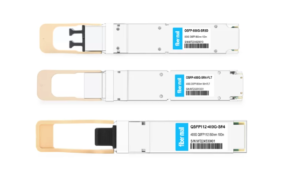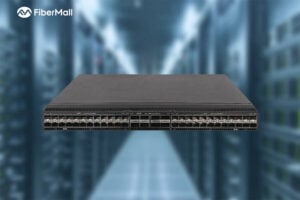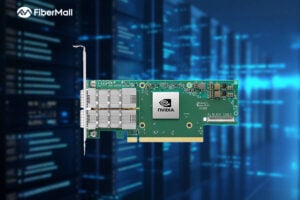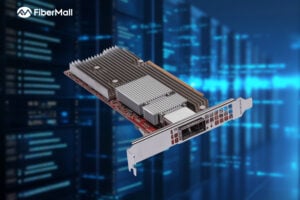- Catherine

John Doe
Answered on 8:10 am
PAM-4 and NRZ are two different modulation techniques that are used to transmit data over an electrical or optical channel. Modulation is the process of changing the characteristics of a signal (such as voltage, amplitude, or frequency) to encode information. PAM-4 and NRZ have different advantages and disadvantages depending on the channel characteristics and the data rate.
PAM-4 stands for Pulse Amplitude Modulation 4-level. It means that the signal can have four different levels of amplitude (or voltage), each representing two bits of information. For example, a PAM-4 signal can use 0V, 1V, 2V, and 3V to encode 00, 01, 11, and 10 respectively. PAM-4 can transmit twice as much data as NRZ for the same symbol rate (or baud rate), which is the number of times the signal changes per second. However, PAM-4 also has some drawbacks, such as higher power consumption, lower signal-to-noise ratio (SNR), and higher bit error rate (BER). PAM-4 requires more sophisticated signal processing and error correction techniques to overcome these challenges. PAM-4 is used for high-speed data transmission such as 400G Ethernet.

NRZ stands for Non-Return-to-Zero. It means that the signal can have two different levels of amplitude (or voltage), each representing one bit of information. For example, a NRZ signal can use -1V and +1V to encode 0 and 1 respectively. NRZ does not return to zero voltage between symbols, hence the name. NRZ has some advantages over PAM-4, such as lower power consumption, higher SNR, and lower BER. NRZ is simpler and more robust than PAM-4, but it also has a lower data rate for the same symbol rate. NRZ is used for short-distance data transmission such as 100G Ethernet.

When a signal is referred to as “25Gb/s NRZ” or “25G NRZ”, it means the signal is carrying data at 25 Gbit / second with NRZ modulation. When a signal is referred to as “50G PAM-4”, or “100G PAM-4” it means the signal is carrying data at a rate of 50 Gbit / second, or 100 Gbit / second, respectively, using PAM-4 modulation.
People Also Ask
InfiniBand vs. Ethernet: The Battle Between Broadcom and NVIDIA for AI Scale-Out Dominance
The Core Battle in High-Performance Computing Interconnects Ethernet is poised to reclaim mainstream status in scale-out data centers, while InfiniBand continues to maintain strong momentum in the high-performance computing (HPC) and AI training sectors. Broadcom and NVIDIA are fiercely competing for market leadership. As artificial intelligence models grow exponentially in
From AI Chips to the Ultimate CPO Positioning Battle: NVIDIA vs. Broadcom Technology Roadmap Showdown
In the era driven by artificial intelligence (AI) and machine learning, global data traffic is multiplying exponentially. Data center servers and switches are rapidly transitioning from 200G and 400G connections to 800G, 1.6T, and potentially even 3.2T speeds. Market research firm TrendForce predicts that global shipments of optical transceiver modules
H3C S6550XE-HI Series 25G Ethernet Switch: High-Performance 25G/100G Solution for Campus and Metro Networks
The H3C S6550XE-HI series is a cutting-edge, high-performance, high-density 25G/100G Ethernet switch developed by H3C using industry-leading professional ASIC technology. Designed as a next-generation Layer 3 Ethernet switch, it delivers exceptional security, IPv4/IPv6 dual-stack management and forwarding, and full support for static routing protocols as well as dynamic routing protocols including
Switching NVIDIA ConnectX Series NICs from InfiniBand to Ethernet Mode: A Step-by-Step Guide
The NVIDIA ConnectX Virtual Protocol Interconnect (VPI) series network interface cards (NICs)—including models such as ConnectX-4, ConnectX-5, ConnectX-6, ConnectX-7, and ConnectX-8 (commonly abbreviated as CX-4/5/6/7/8)—represent a rare class of dual-mode adapters in the industry. A single card enables seamless switching between InfiniBand (IB) and Ethernet physical networks without hardware replacement.
Broadcom Launches the Industry’s First 800G AI Ethernet NIC: Thor Ultra, Fully Compliant with UEC Standards
In a groundbreaking move for AI networking, Broadcom has unveiled the Thor Ultra, the industry’s first 800G AI Ethernet network interface card (NIC) chip that fully complies with the Ultra Ethernet Consortium (UEC) specifications. This innovative PCIe card enables seamless interconnections among hundreds of thousands of diverse XPUs, powering next-generation
Essential Fiber Cleaners and Tools from FiberMall: Your Complete Guide to Maintaining High-Performance Networks
In the fast-paced world of data centers, cloud computing, enterprise networks, and telecommunications, reliable fiber optic connections are the backbone of seamless data transmission. However, even the most advanced fiber optic infrastructure can falter if connectors are contaminated with dust, oils, or debris. This is where high-quality fiber cleaners and
Related Articles

800G SR8 and 400G SR4 Optical Transceiver Modules Compatibility and Interconnection Test Report
Version Change Log Writer V0 Sample Test Cassie Test Purpose Test Objects:800G OSFP SR8/400G OSFP SR4/400G Q112 SR4. By conducting corresponding tests, the test parameters meet the relevant industry standards, and the test modules can be normally used for Nvidia (Mellanox) MQM9790 switch, Nvidia (Mellanox) ConnectX-7 network card and Nvidia (Mellanox) BlueField-3, laying a foundation for

InfiniBand vs. Ethernet: The Battle Between Broadcom and NVIDIA for AI Scale-Out Dominance
The Core Battle in High-Performance Computing Interconnects Ethernet is poised to reclaim mainstream status in scale-out data centers, while InfiniBand continues to maintain strong momentum in the high-performance computing (HPC) and AI training sectors. Broadcom and NVIDIA are fiercely competing for market leadership. As artificial intelligence models grow exponentially in

From AI Chips to the Ultimate CPO Positioning Battle: NVIDIA vs. Broadcom Technology Roadmap Showdown
In the era driven by artificial intelligence (AI) and machine learning, global data traffic is multiplying exponentially. Data center servers and switches are rapidly transitioning from 200G and 400G connections to 800G, 1.6T, and potentially even 3.2T speeds. Market research firm TrendForce predicts that global shipments of optical transceiver modules

H3C S6550XE-HI Series 25G Ethernet Switch: High-Performance 25G/100G Solution for Campus and Metro Networks
The H3C S6550XE-HI series is a cutting-edge, high-performance, high-density 25G/100G Ethernet switch developed by H3C using industry-leading professional ASIC technology. Designed as a next-generation Layer 3 Ethernet switch, it delivers exceptional security, IPv4/IPv6 dual-stack management and forwarding, and full support for static routing protocols as well as dynamic routing protocols including

Switching NVIDIA ConnectX Series NICs from InfiniBand to Ethernet Mode: A Step-by-Step Guide
The NVIDIA ConnectX Virtual Protocol Interconnect (VPI) series network interface cards (NICs)—including models such as ConnectX-4, ConnectX-5, ConnectX-6, ConnectX-7, and ConnectX-8 (commonly abbreviated as CX-4/5/6/7/8)—represent a rare class of dual-mode adapters in the industry. A single card enables seamless switching between InfiniBand (IB) and Ethernet physical networks without hardware replacement.

Broadcom Launches the Industry’s First 800G AI Ethernet NIC: Thor Ultra, Fully Compliant with UEC Standards
In a groundbreaking move for AI networking, Broadcom has unveiled the Thor Ultra, the industry’s first 800G AI Ethernet network interface card (NIC) chip that fully complies with the Ultra Ethernet Consortium (UEC) specifications. This innovative PCIe card enables seamless interconnections among hundreds of thousands of diverse XPUs, powering next-generation

Essential Fiber Cleaners and Tools from FiberMall: Your Complete Guide to Maintaining High-Performance Networks
In the fast-paced world of data centers, cloud computing, enterprise networks, and telecommunications, reliable fiber optic connections are the backbone of seamless data transmission. However, even the most advanced fiber optic infrastructure can falter if connectors are contaminated with dust, oils, or debris. This is where high-quality fiber cleaners and
